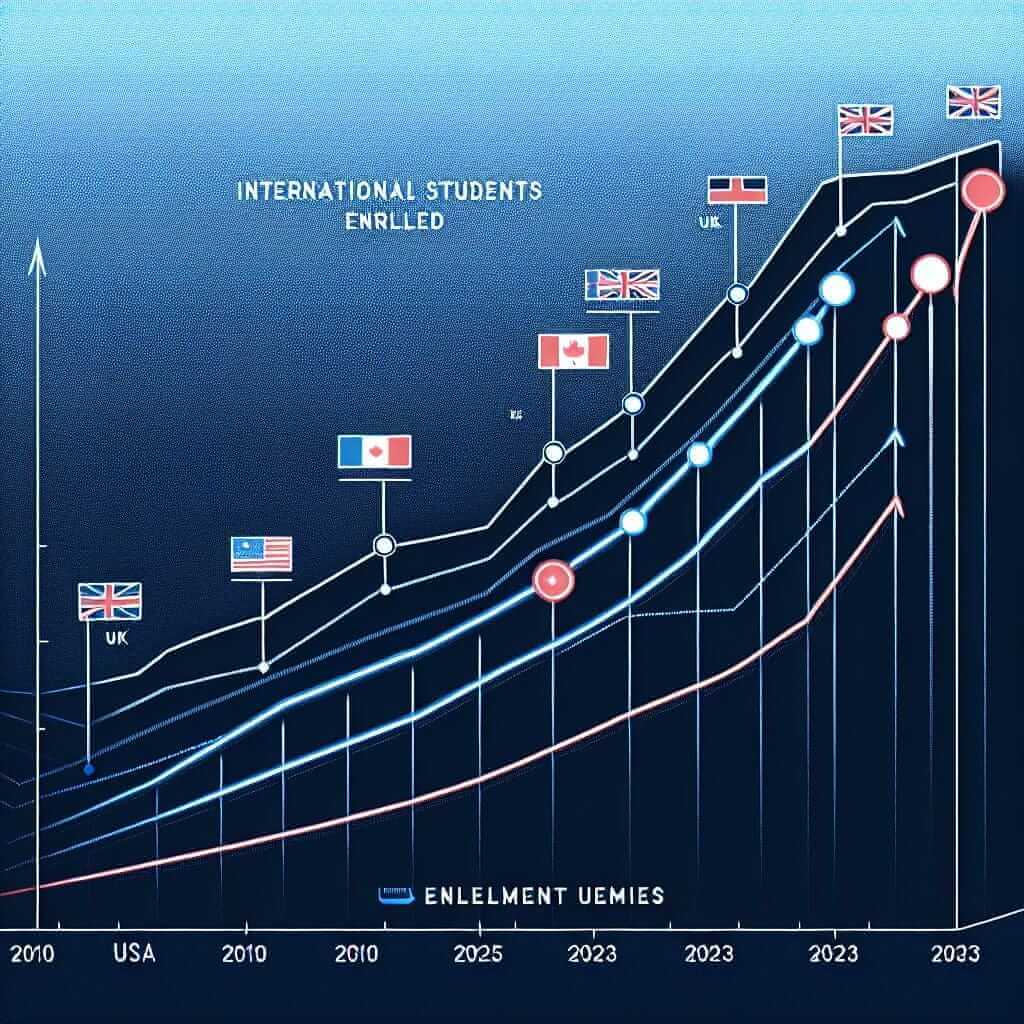The IELTS Writing Task 1 often presents data in various forms, requiring test-takers to showcase their analytical and reporting skills. One common theme is analyzing trends in international student enrollments. This article explores effective strategies for tackling such tasks, focusing on the keyword “International Student Enrollments in the USA, UK, Australia, Canada, and Germany (2010-2023)”. We’ll dissect potential IELTS questions, analyze real data, and craft a band-scoring response, equipping you with the tools for IELTS writing success.
Nội dung bài viết
Understanding the Task: Potential IELTS Questions
Before diving into data analysis, let’s examine how this topic might appear in the IELTS exam:
- The line graph below shows the number of international students enrolled in universities in the USA, UK, Australia, Canada, and Germany between 2010 and 2023. Summarize the information by selecting and reporting the main features and make comparisons where relevant.
- The table illustrates the percentage change in international student enrollments across five countries: the USA, UK, Australia, Canada, and Germany, from 2010 to 2023. Write a report for a university lecturer describing the information shown.
These questions highlight key aspects examiners look for: accurate data interpretation, clear reporting, and relevant comparisons.
Sample Task: Analyzing International Student Enrollment Trends
For our demonstration, let’s focus on the first question type (line graph) and create a sample scenario:
Data Visualization
(Insert a line graph here depicting hypothetical data for international student enrollments in the USA, UK, Australia, Canada, and Germany from 2010 to 2023. The graph should show some clear trends and fluctuations to allow for analysis and comparison.)

Dissecting the Task
Task: The line graph below shows the number of international students enrolled in universities in the USA, UK, Australia, Canada, and Germany between 2010 and 2023. Summarize the information by selecting and reporting the main features and make comparisons where relevant.
Understanding the Requirements:
- Data Type: Line graph showing trends over time.
- Key Information: International student enrollments.
- Countries: USA, UK, Australia, Canada, Germany.
- Time Period: 2010 to 2023.
- Task Focus: Summarizing main trends, making comparisons.
Model Answer
The line graph illustrates the trends in international student enrollments across five major destinations – the USA, UK, Australia, Canada, and Germany – over a 13-year period from 2010 to 2023.
Overall, the USA consistently attracted the highest number of international students throughout the period. While all countries experienced growth in enrollments, Australia showed the most dramatic increase.
In 2010, the USA hosted approximately 700,000 international students, followed by the UK with around 400,000. Australia and Canada had comparatively fewer enrollments, at 300,000 and 250,000 respectively, while Germany lagged behind with roughly 200,000.
Over the next decade, international student numbers in the USA rose steadily, reaching a peak of just over 900,000 in 2020. Similarly, the UK saw a gradual increase, reaching approximately 600,000 by 2023. Australia, however, experienced the most significant growth, with enrollments more than doubling to surpass 650,000 by 2023. Canada also observed a steady rise, reaching around 500,000, while Germany’s numbers plateaued at around 350,000 after a period of initial growth.
Word Count: 179 words
Writing Tips: Mastering IELTS Data Analysis
- Paraphrase the Question: Don’t just copy the question; rephrase it in your introduction.
- Overview: Provide a general overview of the main trends in the second paragraph.
- Specific Details: Support your overview with specific data points and comparisons.
- Time Management: Allocate time for planning, writing, and proofreading.
- Vocabulary & Grammar: Use a range of vocabulary and grammatical structures accurately.
Essential Vocabulary:
- Trend (noun): A general direction of change; a pattern.
- Enrollment (noun): The act of officially joining a school or course.
- Fluctuation (noun): An irregular rising and falling in number or amount; a variation.
- Consistently (adverb): In every case or on every occasion; invariably.
- Dramatic (adjective): Sudden and striking; noticeable.
- Lag behind (phrasal verb): To make slower progress than another.
- Plateau (verb/noun): To reach a state of little or no change after a period of activity or progress.
- Surpass (verb): To exceed; be greater than.
Conclusion: Achieving IELTS Writing Excellence
Mastering the art of data analysis for IELTS Writing Task 1 requires a combination of analytical skills, language proficiency, and exam strategy. By understanding the task requirements, practicing data interpretation, and utilizing appropriate vocabulary and grammar, you can confidently approach this section and aim for a Band 7+ score. Remember to analyze trends, highlight key features, and support your statements with specific data points from the provided visuals. Good luck!